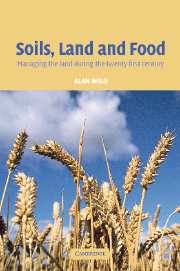Book contents
- Frontmatter
- Contents
- Preface
- Acknowledgements
- 1 Managing land for food production in the twenty-first century: an outline
- 2 Natural resources for sustainable land management
- 3 The development of agriculture and systems of land management
- 4 Maintaining and improving soil fertility
- 5 Land degradation and its control
- 6 Raising yields: use of fertilizers
- 7 Raising yields: water for rainfed crops and irrigation
- 8 Managing change of land use: seven examples
- 9 Increasing and sustaining agricultural production
- 10 Increasing agricultural production: the examples of Africa, India and China
- 11 Prospects and uncertainties
- References
- Index
- Frontmatter
- Contents
- Preface
- Acknowledgements
- 1 Managing land for food production in the twenty-first century: an outline
- 2 Natural resources for sustainable land management
- 3 The development of agriculture and systems of land management
- 4 Maintaining and improving soil fertility
- 5 Land degradation and its control
- 6 Raising yields: use of fertilizers
- 7 Raising yields: water for rainfed crops and irrigation
- 8 Managing change of land use: seven examples
- 9 Increasing and sustaining agricultural production
- 10 Increasing agricultural production: the examples of Africa, India and China
- 11 Prospects and uncertainties
- References
- Index
Summary
During the twenty-first century one of the greatest challenges for mankind will be to ensure that the production of food is sufficient to meet the demand of an extra two billion people by 2025 and three billion by 2050. Most of this increase in demand will be in countries of the developing world. If those living on the edge of starvation are to be better fed the increase will need to be bigger than the increase in population: a doubling of global food production may be required by the middle of the century.
From the early days of agriculture more land was brought into cultivation as populations increased (cause and effect are intertwined). Farming systems adapted to the local environment evolved from hunting and gathering economies. New crops and domesticated animals were introduced from other regions, more land was cultivated and new techniques were developed. There was success but also failure as some soils lost their fertility by nutrient mining and, more dramatically, by erosion. Although most people in the world have an adequate diet, whether we can meet the demand for food and still retain our prime ecosystems is a question for the future.
The underlying theme throughout this book is the standard of land and soil management, soil being essentially a non-renewable resource. The key player is the farmer, who will use good management skills if he has security of land tenure.
- Type
- Chapter
- Information
- Soils, Land and FoodManaging the Land during the Twenty-First Century, pp. viii - ixPublisher: Cambridge University PressPrint publication year: 2003



